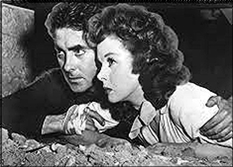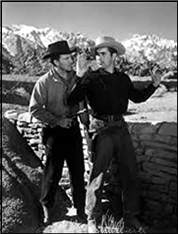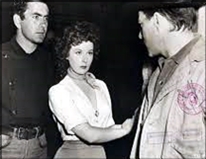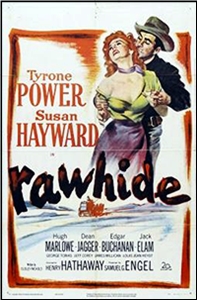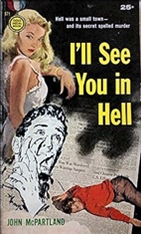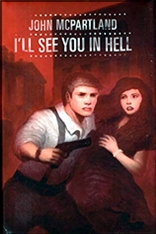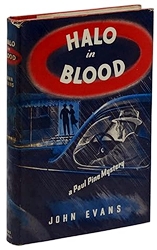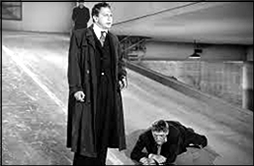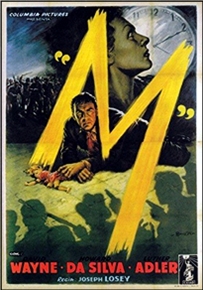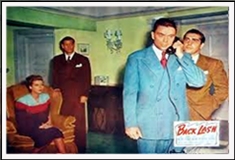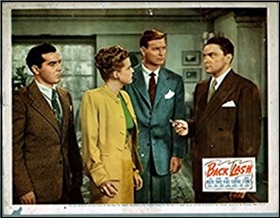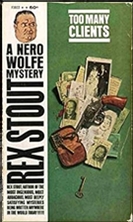Sun 14 Jul 2024
Nero Wolfe on Page and (Small U.S.) Screen: “Eeny Meeny Murder Mo” by Matthew R. Bradley
Posted by Steve under Reviews , TV mysteriesNo Comments
“Eeny Meeny Murder Mo”
by Matthew R. Bradley
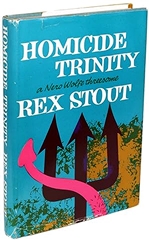
The Final Deduction (1961) sees the return of Ben Dykes, head of the Westchester County detectives in the Zeck trilogy, and introduces their D.A. du jour, Clark Hobart, and Captain Saunders of the State Police; Ben earns a “Competent and admirable” from Wolfe, whose weight is given as 285 pounds. Stout is inconsistent about Archie’s weekly poker game with Lon and the ’teers, now held on Wednesday, not Saturday as in “The Next Witness” (1955), with Saul as rotating, not regular, host. Ditto Archie’s Ohio birthplace, given in Too Many Women (1947) as Canton and in “The Cop-Killer” (1951) as Chillicothe, invoked here when he recalls his Aunt Anna’s chicken pie.
Wolfe pledges temporary silence to his client, Althea Vail, whose husband, Jimmy, and secretary, Dinah Utley, are murdered after conspiring to fake his kidnapping and commit tax fraud … the titular deduction being that she killed them. To keep his promise, he flees the brownstone with Archie—avoiding Cramer by taking overnight refuge in the home of Doc Vollmer while his son, Bill, is away at school — and, in appreciation, sends orchids to Vollmer and his assistant, Helen Gillard. Archie hands Lon his “fattest scoop” ever, plus a “second hot exclusive” within three days, while oft-mentioned A.D.A. Mandelbaum has suddenly become “Mandel,” and will apparently remain so in all subsequent appearances.
Two of the novellas in Homicide Trinity (1962) were serialized in The Saturday Evening Post — “Counterfeit for Murder” (as “The Counterfeiter’s Knife,” January 14-28, 1961) and “Death of a Demon” (June 10-24, 1961); “Eeny Meeny Murder Mo” bowed in Ellery Queen’s Mystery Magazine #220 (March 1962). Although Stout rarely revised his work, “Assault on a Brownstone,” a radically different early draft of “Counterfeit,” appeared in the posthumous collection Death Times Three (1985). The “Demon,” Barry Hazen, uses his p.r. business as a front for blackmail until one of the victims he tortures puts a hole in him, and tries to frame Mrs. Hazen with the very gun he used to kill her father years ago.
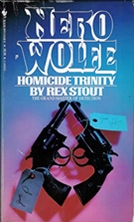
“Counterfeit” opens with back-to-back visits by showbiz landlady Hattie Annis — told to return when Wolfe descends from the plant rooms, entrusting Archie with a package for which a hit-and-run driver wings her — and aspiring actress Tamiris Baxter, a concerned tenant to whom he admits nothing. Discovered in Hattie’s parlor, the package contains c. $10,000 in new $20 bills; after stonewalling Albert Leach of the Treasury Department’s Secret Service Division, asking about both women, Archie confirms it as phony. But on arrival at the house with Hattie, who hates cops and hopes to split a newspaper’s reward for finding a counterfeiter, he spots Tammy on the parlor’s floor with a knife in her chest.
Turns out she was an undercover T-woman, the counterfeiter/killer presumed to be one of Hattie’s other four tenants, who come to the brownstone en masse at her behest when her intransigence gets her arrested. After a turf battle over confiscation of the bills, Leach’s Federal court order trumping Cramer’s, Archie talks with D.A. Macklin. This took a hard left seven pages into “Assault,” in which the hit and run is fatal, Tammy lives — and even has romantic potential, and Leach’s titular search for the package Archie cached in Grand Central piques Wolfe into action; Stout’s biographer, John McAleer, observes that Hattie 2.0 engages them in “some of the liveliest dialogue to be found anywhere in the corpus.”
In “Eeny,” Bertha Aaron comes seeking aid: the private secretary to Lamont Otis saw an unidentified younger partner of Otis, Edey, Heydecker, and Jett meeting secretly with the opposing client, Rita Sorell. Not surprisingly, Wolfe — up in the plant rooms — refuses to touch a case even tangentially involving Rita and Morton’s divorce, so he tells Archie to get rid of her, but on returning to the office, he finds somebody has beaten him to it. She has been strangled with Wolfe’s own necktie, left on his desk after he got a spot on it, and is presumed, while alone in the office, to have intercepted a call from said partner, who’d followed her, offered to explain … and opportunistically killed her once she admitted him.
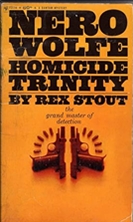
Otis arrives with associate Ann Paige, who is asked to wait in — and decamps through the window of — the front room while he reads the statement Archie gave Cramer. He agrees to help with background on Frank Edey (drafted the Sorrells’ marriage agreement), Miles Heydecker (represented gold-digger/ex-actress Rita, née Ramsey, when sued by a former agent), and Gregory Jett (a spendthrift, rumored to be interested in Ann). Archie writes a card claiming that Rita was seen in the lunchroom, hoping that she can be smoked out of the Churchill and followed by the ’teers; he returns home to find Jett, who was tipped off by Ann, his alleged fiancée, and thinks Bertha might have known of a dalliance with Rita.
Just after Edey and Heydecker arrive to complete the set, Rita calls and “admits” she was with Jett, so Wolfe tells them she named the man, although “not satisfied of her veracity,” if not who. “We knew that one of three men had committed murder, and how and when. Okay, which one? Eeny meeny murder mo”; Cramer and Purley arrive with warrants for them both, leaving in defeat after Wolfe calls Parker and their bluff. He then arranges for the other interested parties to be listening in from the front room as he confronts Rita with the truth — it was Heydecker, not Jett, who met with her, followed Bertha to Wolfe’s, and phoned Rita to warn her of possible exposure, while Rita herself committed the murder…
“Eeny, Meeny, Murder, Moe” (sic; 6/3/01) and the subsequent episode of A Nero Wolfe Mystery, “Disguise for Murder” (6/17/01) — both directed by John L’Ecuyer, here making his series debut, and adapted by Sharon Elizabeth Doyle — were attached for international broadcast and DVD in a faux telefilm, Wolfe Stays In. As with “Door to Death” (6/4/01) and “Christmas Party” (7/1/01), yoked as Wolfe Goes Out, the novellas were spaced years apart. Doyle links these two with original material about those poker games, now played on Thursday with Lon (Saul Rubinek), Orrie (Trent McMullen), and Saul (Conrad Dunn), over which Archie (Timothy Hutton) explains Wolfe’s (Maury Chaykin) sparerib mishap.
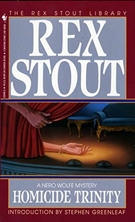
Bertha (Christine Brubaker) says she fears the news might kill Otis (George Plimpton), who is 75 and has a bad heart, and that when she’d confronted the “traitor,” his reaction precluded an innocent explanation, hence her visit. Of course, Cramer (Bill Smitrovich) is convinced that he withheld the name she refused to provide until or unless Wolfe took the case, while Archie insists that, even absent a client or a fee, “this aggression will not stand,” per the Dude. With Angela (Janine Theriault) sequestered, Wolfe tells Otis, “My self-esteem has been severely injured,” warning him against an attempt at damage control by shielding the killer, but Otis insists he will not put the firm’s interests ahead of justice.
Invoked but never onstage in the novella, Morton (Howard Hoover) is briefly shown here in flashbacks with Rita (Kari Matchett); she “wanted more than half, and … had carefully collected evidence of certain enterprises” of his, which any of the partners could provide. Chaykin beautifully depicts how, due to his rancor at the killer, “I can’t think clearly. My brain-processes are muddled,” and he even declines Fritz’s (Colin Fox) offer of food. Jett (Robert Bockstael), Edey (Wayne Best), and Hydecker (sic; David Schurmann) all come to the brownstone after grilling by the authorities, but Wolfe considers their alibis for the time of the lunchroom meeting worthless, and they were in conference during the murder.
Up next: The Mother Hunt
Editions cited–
The Final Deduction: Bantam (1963)
Homicide Trinity: Bantam (1970)
Death Times Three: Bantam (1985)
Online source —



